
power tool "live" and could give the operator an
electric shock.
b)
Always hold the power tool securely with both
hands on the grips provided. Keep the grips dry,
clean and free from oil and grease.
c)
Improve the blood circulation in your fingers by
relaxing your hands and exercising your fingers
during breaks between working.
d)
Avoid touching rotating parts. Switch the power
tool on only after bringing it into position at the
workpiece.
Touching rotating parts, especially rotat-
ing insert tools, may lead to injury.
e)
Activate the safety lock (forward / reverse switch
in the middle position) before storing or trans-
porting the power tool.
f)
The power tool is not intended for use by children,
by debilitated persons or those who have received
no instruction or training.
g)
Children must be instructed not to play with the
power tool.
h) Dust from material such as paint containing lead,
some wood species, minerals and metal may be
harmful. Contact with or inhalation of the dust may
cause allergic reactions and/or respiratory diseases
to the operator or bystanders. Certain kinds of dust
are classified as carcinogenic such as oak and beech
dust especially in conjunction with additives for wood
conditioning (chromate, wood preservative). Material
containing asbestos must only be treated by special-
ists.
Where the use of a dust extraction device is
possible it shall be used. To achieve a high level
of dust collection, use a suitable vacuum cleaner
of the type recommended by Hilti for wood dust
and/or mineral dust together with this tool. Ensure
that the workplace is well ventilated. The use of a
dust mask of filter class P2 is recommended. Fol-
low national requirements for the materials you
want to work with.
5.3.2 Power tool use and care
a)
Secure the workpiece. Use clamps or a vice to
secure the workpiece.
The workpiece is thus held
more securely than by hand and both hands remain
free to operate the power tool.
b)
Check that the insert tools used are compatible
with the chuck system and that they are secured
in the chuck correctly.
5.3.3 Battery tool use and care
a)
Do not expose batteries to high temperatures or
fire.
This presents a risk of explosion.
b)
Do not disassemble, squash or incinerate batter-
ies and do not subject them to temperatures over
80°C.
A risk of fire, explosion or injury through con-
tact with caustic substances may otherwise result.
c)
Do not use batteries other than those approved
for use with the applicable power tool or appli-
ance.
Use of other batteries or use of the battery for
purposes for which it is not intended presents a risk
of fire and explosion.
d)
Observe the special instructions applicable to the
transport, storage and use of Li-ion batteries.
e)
Avoid short-circuiting the battery. Check that the
terminals on the battery and in the power tool
are free from foreign objects before inserting the
battery in the power tool.
Short circuiting the bat-
tery terminals presents a risk of fire, explosion and
chemical burns.
f)
Do not charge or continue to use damaged bat-
teries (e.g. batteries with cracks, broken parts,
bent or pushed-in and/or pulled-out contacts).
g)
Hold power tool by insulated gripping surfaces
when performing an operation where the fastener
may contact hidden wiring or its own cord.
Fasten-
ers contacting a “live” wire may make exposed metal
parts of the power tool “live” and could give the
operator an electric shock.
5.3.4 Electrical safety
Before beginning work, check the working area (e.g.
using a metal detector) to ensure that no concealed
electric cables or gas and water pipes are present.
External metal parts of the power tool may become
live, for example, when an electric cable is damaged
accidentally. This presents a serious risk of electric shock.
5.3.5 Work area
a)
Ensure that the workplace is well lit.
b)
Ensure that the workplace is well ventilated.
Ex-
posure to dust at a poorly ventilated workplace may
result in damage to the health.
5.3.6 Personal protective equipment
The user and any other persons in the vicinity must
wear suitable eye protection, a hard hat, ear protec-
tion, protective gloves and breathing protection while
the tool is in use.
en
20
Printed: 08.07.2013 | Doc-Nr: PUB / 5070635 / 000 / 01
Summary of Contents for SF 144-A
Page 2: ...1 2 3 5 6 7 4 8 9 1 Printed 08 07 2013 Doc Nr PUB 5070635 000 01 ...
Page 155: ...ja 152 ...
Page 156: ...ja 153 ...
Page 157: ...ja 154 ...
Page 158: ...ja 155 ...
















































